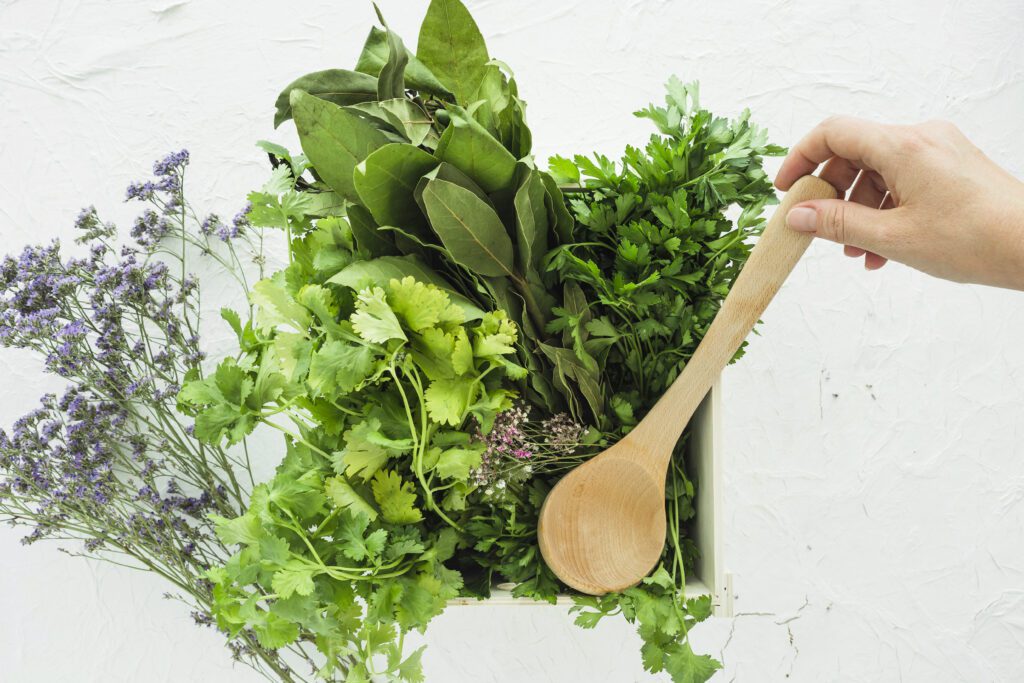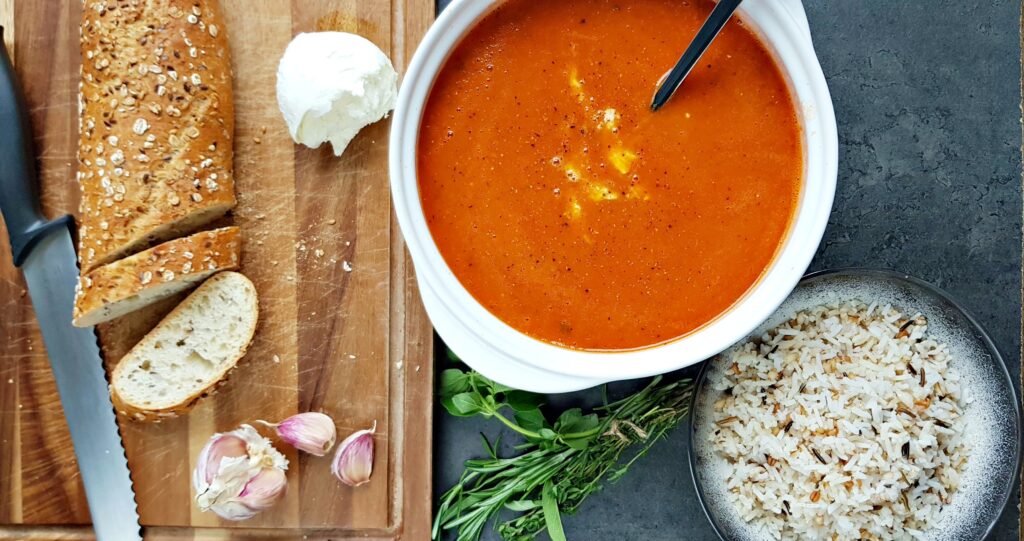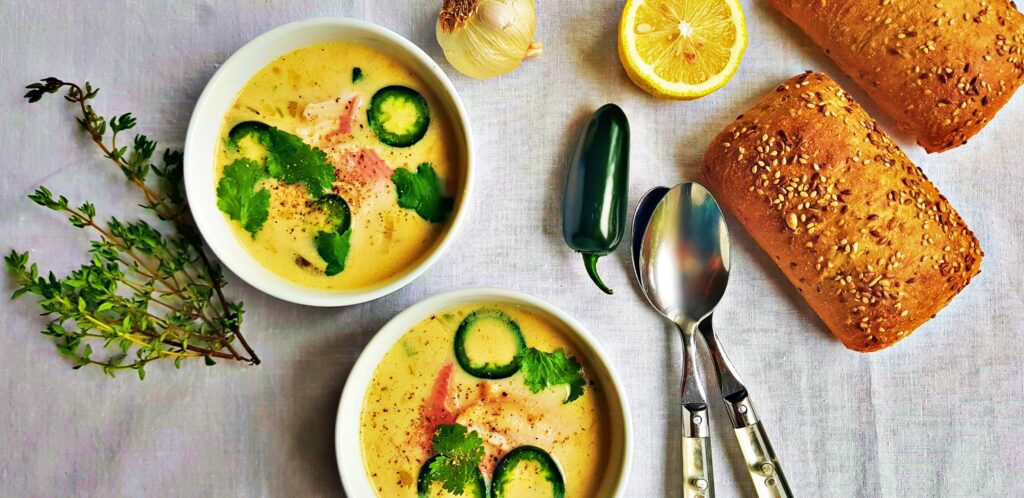In this blog post, I will provide practical tips for pairing Fresh Herbs with your favorite dishes.
Those green, fragrant plants can make your food taste amazing! They can turn your everyday dishes into something really special.
So, let’s chat about how to use Fresh Herbs and make your meals taste fantastic.
List of common fresh herbs
- Basil has a fresh, slightly sweet taste, and it’s famous for its use in Italian dishes like pasta and pizza.
- Mint is super refreshing and has a cool, zesty flavor. It’s great for making drinks like minty lemonade or adding to desserts like chocolate chip mint ice cream.
- Cilantro (Coriander) has a bright, citrusy taste. People either love it or think it tastes like soap! It’s perfect for fresh salsas, tacos, and some Asian dishes.
- Parsley is mild and a little earthy. It’s often used as a garnish to make dishes look pretty, but it can also add a subtle flavor to salads and soups. Or you can add it to your green smoothie.
- Rosemary has a strong, piney scent. It’s awesome for roasting meats, like chicken or lamb, and even for making crispy rosemary potatoes with garlic.
- Thyme is earthy and slightly peppery. It’s a great addition to stews, soups, and roasted veggies, especially when you want a cozy, warm taste.
- Dill is fresh and a bit tangy. It’s famous for pickles but also works well with seafood, like salmon or shrimp.
- Chives taste like mild onions. They’re often snipped and sprinkled on top of dishes like baked potatoes, soups, or salads.
- Oregano has a robust, Mediterranean flavor. It’s a must for pizza, pasta sauces, and Greek or Italian dishes.
- Sage is earthy with a hint of lemon. It’s perfect for adding a rich taste to dishes like stuffing and roasted chicken.
Understanding Flavor Profiles
- Sweet: This is like your dessert buddy. Sweet flavor profiles are all about sugary goodness. Think of chocolate cake or ripe strawberries. Some herbs can add a touch of sweetness, like basil in a fruity salad.
- Savory: Savory is like the comfy, hearty flavor. It’s what you get from roasted meats, soups, and pasta. Herbs like thyme and rosemary are often used to make dishes taste savory.
- Spicy: Spicy is the heat in your food. It’s what you get from chili peppers or black pepper. Some herbs, like cilantro, can add a bit of spiciness to your dishes.
- Sour: Sour is like a tangy, zesty kick. It’s what you taste in lemons, vinegar, or yogurt. Herbs like lemon thyme or tarragon can bring a hint of sourness to your cooking.
- Bitter: Bitter is a bold, strong taste. It’s in things like dark chocolate or bitter greens. Herbs like parsley can have a mild bitterness that balances out other flavors.
- Umami: Umami is a savory, meaty flavor. It’s found in things like mushrooms or soy sauce. Some herbs, like sage, can add a touch of umami to your dishes.
Dos and Don’ts
Dos:
- Start with a Pinch: Begin with a small amount of fresh herbs, especially if you’re new to a particular herb. You can always add more if needed, but it’s hard to remove excess herbs once they’re in the dish.
- Taste as You Go: Do taste your dish as you add herbs. This helps you gauge if the flavor is just right or if you need to adjust. Remember, you can’t undo too much herb, but you can add more if it’s too mild.
- Mix and Match: Do experiment with combining different herbs. Mixing herbs can create unique and exciting flavors. Just ensure they complement each other and the dish.
- Add at the Right Time: Different herbs can be added at different times during cooking. Some, like rosemary, thyme, or bay leaves, are good for simmering and can be added early. Others, like basil, cilantro, and parsley, are best added just before serving to maintain their fresh flavor.
Don’ts:
- Don’t Overdo It: Don’t go overboard with herbs. Using too much can overpower the other flavors in your dish. It’s all about balance.
- Avoid Using Dried Herbs as a 1:1 Substitute: Dried herbs have a more concentrated flavor than fresh ones. Don’t assume you can use them in equal amounts. Typically, you’ll need less dried herbs than fresh.
- Don’t Crush Too Early: Don’t crush or chop fresh herbs too early. It’s best to prepare them just before using them to retain their freshness and flavor.
- Steer Clear of Tough Stems: For most herbs, avoid using tough stems, as they can be bitter. Stick to the tender leaves and soft stems.
Preparing Fresh Herbs
- Wash Gently: It’s a good idea to give your fresh herbs a gentle wash under cold water to remove any dirt or residue. Just be careful not to rub them too hard, as they can bruise easily.
- Pat Dry: After washing, pat the herbs dry with a clean kitchen towel or paper towel. You want them to be mostly dry, as excess moisture can dilute flavors and make your dish watery.
- Remove Tough Stems: Many herbs have tender leaves and stems, but some have tougher stems. For the best flavor, remove the tough stems and use only the leaves and soft stems. For example, with basil, you’d want to pluck the leaves and discard the woody stem.
- Chop Right Before Use: To keep the herbs as fresh as possible, chop or snip them just before adding them to your dish. This helps preserve their flavor and aroma.
Storing Fresh Herbs
1. In the Refrigerator:
- For most fresh herbs like basil, cilantro, parsley, and mint, the refrigerator is your friend.
- First, trim the tough stems slightly and remove any damaged or wilted leaves.
- Then, wrap the herbs loosely in a damp paper towel or kitchen cloth. This helps maintain their moisture without making them soggy.
- Place the wrapped herbs in a plastic bag or an airtight container with a lid.
- Store them in the refrigerator’s crisper drawer, where it’s slightly more humid.
2. In the Freezer:
- If you have an abundance of fresh herbs and can’t use them all quickly, consider freezing them.
- Chop the herbs or leave them whole, depending on your preference.
- Place them in an ice cube tray and cover with water or olive oil. Freeze until solid.
- Once frozen, transfer the herb cubes into a freezer-safe bag or container.
- Label them with the herb type and date for easy identification.
- You can pop an herb cube directly into your dishes while cooking.
3. Herb Bouquet:
- Another method to extend shelf life is to create an herb bouquet.
- Place your herbs in a glass or jar filled with an inch or two of water, like you would with flowers.
- Cover the herbs loosely with a plastic bag and secure it with a rubber band or string.
- Store the herb bouquet in the refrigerator, and change the water every few days.
Fresh Herbs in Your Dishes
Basil:
Cilantro:
Bowl of Goodness: Baked Salmon with Broccoli & Shiitake
Sweet Potato Curry with Marinated Tofu
Wraps with Beans & Bell Pepper
Rosemary:
Roasted Lamb with Garlic and Rosemary
Garlic-Rosemary Roasted Potatoes
Dill:
The Best Zucchini Dip from My Childhood
Thyme:
Amazingly Tasty Chowder with a Trout Fillet
Quick & Easy Tomato Soup with Fresh Herbs
Mint:
Greek Watermelon Salad with Mint & Feta
Parsley:
A Taste of Ukraine: The Authentic Borsh recipe
Hearty & Healthy: Vegetarian Borsh Recipe (Instant Pot)
Chives:
Baked Potato with Sour Cream & Chives
Oregano:
Greek-Style Grilled Chicken Skewers
Sage:
Don’t be afraid to innovate! Part of the fun of cooking is experimenting. Don’t hesitate to try unconventional herb pairings. Sometimes, the most unexpected combinations turn out to be fantastic.









